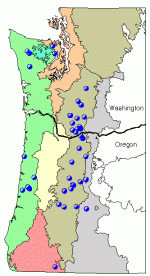Together with the Wind River Canopy Crane site, Andrews LTER maintains a network of long-term vegetation plots across western Oregon and Washington. A new report posted on the Andrews website summarizes data from the plot series.
"Long-term observations are the only direct means to document and understand the intrinsically slow changes of our forests," says Mark Harmon, Andrews LTER PI, "which are dominated by long-lived tree species -- individuals commonly live 400 to 1000 years."
The vegetation plots are used to examine patterns and rates of forest succession, and to measure tree growth and mortality. The network of plots extends through much of western Oregon and Washington, with sites representing most of the major forest zones and successional stages in the region. The duration of records ranges from temporary plots measured a single time to permanent plots with up to 80 years of observations. "Hopefully this is the first of many reports that we will publish on the website" Harmon says. "Hopefully this is the first of many reports that we will publish on the website" Harmon says.

 Enlarge this image
Enlarge this image